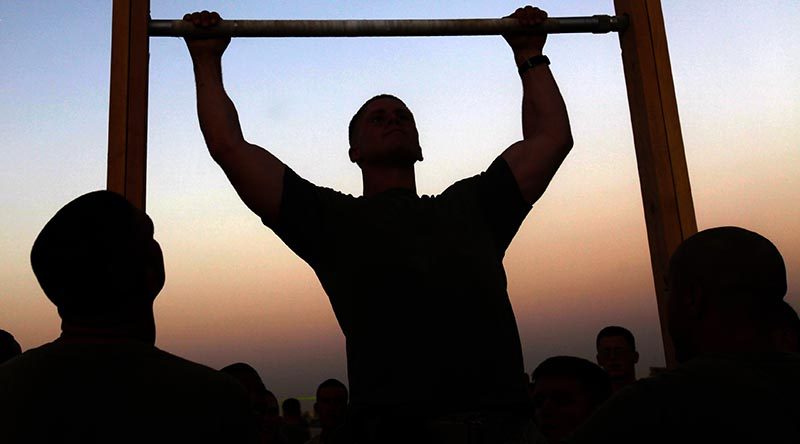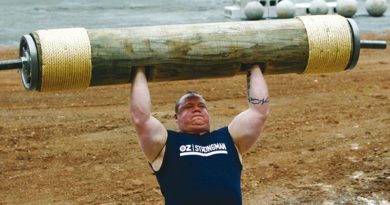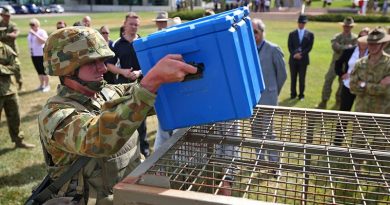Military Fitness – Part 19


If you were going to put together a list of the exercises that people fear the most, then, for many people, pull-ups (or chin-ups or heaves) would be near the top of the list. In fact the world seems to be neatly divided into two types of people. Those who can do lots of chin-ups without too much effort and those who absolutely dread chin-ups because they can only squeeze out a few at best. This, of course, is a major problem for anyone looking to join the military or already serving because, unlike some other exercises, the pull-up is a supremely functional exercise that carries over to many combat situations.
 Couch to Commando by Don Stevenson is a 165-page e-book with programs in 6 different levels to progress anyone from couch potato to commando candidate.
Couch to Commando by Don Stevenson is a 165-page e-book with programs in 6 different levels to progress anyone from couch potato to commando candidate.
20% of proceeds from the sale of this e-book will be donated to Soldier On
In this article I’ll outline a plan to get you from zero pull-ups to a solid set of five and then, in part two of this article, we’ll look at advanced variations and methods to get from five to 20+ pull-ups.
Because it involves lifting your whole body mass with the relatively small musculature of your upper body, many people struggle with pull-ups and it’s not uncommon for an untrained individual to be capable of even a single rep.
Unlike say a barbell squat or bench press, incremental loading is a bit hard with pull-ups.
This, of course, leads to a significant problem in the gym. How do you get better at something you can’t even come close to doing?
Many of the methods tried by bodybuilding trainers (like doing lots of lat pulldown and using assisted pull-up machines with a fixed line of action) don’t work particularly well.
So, over the past few years, I’ve developed a fairly simple progression for moving clients from pull-up zero to pull-up hero.
Before we look at the training progression, let’s define the different movements you’ll need. Note that the terms pull-up, chin-up and heave are often used to describe different hand placements, but I generally use the terms interchangeably and distinguish between the different grips as overhand, underhand and alternate.
Pull-ups start with the body suspended by the arms from a bar or beam, the arms at full extension. The body is then pulled up in a controlled and smooth manner until the chin clears the bar or beam. At the top, the movement is reversed and the body returns at a controlled speed to the full hang position.
Assisted pull-ups are any pull-up where some percentage of your bodyweight is supported by an external force such as a spotter or rubber band.
The Plan
If you can’t do a single pull-up, the easiest way to get started is to start with assisted pull-ups. These can be done with a spotter but for a more consistent and progressive effect, I highly recommend getting a set of three to four different-strength stretch bands. For guys, try to get a set of three bands that are approximately 2cm, 3cm and 4cm wide. For women, an additional 1cm-wide band may also be required. The wider the band the greater the assistance.
If you haven’t seen these before, they are simply enormous rubber bands that can be used to support part of your weight on the chin-up bar. The band is looped over the bar then through itself and then you put your foot or knee in the loop of the band when hanging from the bar.
Note that although similar to an assisted chin-up machine the bands have a couple of major advantages. First, a set of bands only costs about $100 and fits in a small backpack – plus, the path of assistance is not fixed and therefore your body and legs are free to move through space along the same path that they will eventually take when you graduate to unassisted pull-ups.
Watch this video to see basic pull-up progressions, including the use of bands…
You need to start with a wide band (or even two bands together) that gives you enough assistance to perform sets of two to three pull-ups. Then, three days a week, as the first exercise in your program, perform three to five sets of pull-ups.
After a week or so try to increase the number of reps per set to four and then five.
Once you can do five sets of five reps at a certain level of assistance, it’s time to switch to a slightly weaker band. This will inevitably knock you back to sets of two to three and from there the process begins again through each level of band until you are doing five by five with your thinnest band.
Once you reach this point you should be able to do one to three unassisted pull-ups and you will be able to repeat the process to achieve five by five unaided.
If you can already do a few pull-ups then you can use the same method to build reps by aiming for sets of 10, and when you reach five by 10 on each level, change to the next weaker band.
Conclusion
Pull-ups are not an exercise to be afraid of and, with a little effort and a few rubber bands, you’ll find that you are pumping out pretty good numbers in a month or two.
Next time we’ll look at ways to get to an elite level of pull-ups as well as advanced variations of the basic pull-up.
.
.

.
.






